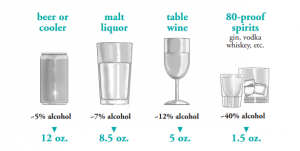ARTICLE SUMMARY: Alcohol stays in your system and is usually detected in urine drug tests 12-24 hours. Still, it can sometimes be detected for up to 80 hours after you end a drinking session. Alcohol can also be tested in saliva for 12 hours after you stop drinking. It can be traced in hair for 48 hours. Blood testing shows how much alcohol is currently present in your blood stream. We review alcohol metabolism, alcohol detection, and drug testing principles for alcohol below.
TABLE OF CONTENTS:
- Peak Levels and Half Life
- Metabolism
- Why Test for Alcohol?
- Alcohol Testing Methods
- Detection Windows
- Signs of a Problem
- Alcohol, Alcoholism, and Addiction
- Your Questions
Usually, the effects of alcohol appear within 10 minutes, but peak levels are reached at about an hour after consummation.
What Is a Standard Drink?
In the United States, a standard drink is any drink that contains about 14 grams of pure alcohol found in:
- 12 ounces of regular beer, which is usually about 5% alcohol
- 5 ounces of wine, which is typically about 12% alcohol
- 1.5 ounces of distilled spirits, which is about 40% alcohol
One serving of alcohol is fully absorbed into the blood stream within 30 minutes to 2 hours after intake. This is because the body can metabolize about 0.25 ounces of alcohol per hour.
Blood Alcohol Concentration (BAC)
The amount of alcohol in your blood is known as “blood alcohol concentration” (BAC). The higher your BAC is, the more impaired you become. Generally speaking, alcohol is absorbed into the blood relatively quickly and metabolized more slowly. Usually the effects appear within 10 minutes, but the peak is reached at about an hour after consummation.
In an average 150 pound person, for example, each drink adds 0.02% to BAC and hour that passes removes 0.01% from it. This is why alcohol concentrations build steadily throughout a drinking session. The Cleveland Clinic provides an online BAC calculator here.
Factors that affect how long alcohol stays in your blood, include:
However, the effects of alcohol vary by individual and by how much alcohol they drink in one session. In fact, the effects and levels of alcohol in the body depend upon a number of factors:
- A person’s size and weight.
- Individual metabolism rate.
- Related food intake.
- The beverage consumed.
One standard drink stays in the body for about 2 hours after you drink it.
How Is Alcohol Metabolized?
Alcohol is absorbed in the body more rapidly than it is metabolized. Because of this, alcohol levels can build up in your system very fast. Less than 10% of the alcohol is removed from the body in breath, sweat, and urine, while about 90% is eliminated by the process of oxidation that occurs in the liver with the action of the enzyme alcohol dehydrogenase (ADH).
How long alcohol lasts in our body is connected with the amount of alcohol you drink. Generally speaking, one unit of alcohol stays in the body for about 2 hours after being taken. One alcohol unit equals one standard drink.
Why Test For Alcohol?
Alcohol impairment within the workplace and while driving can cause:
- Distortion of reality
- Drowsiness
- Impaired judgment
- Loss of concentration
- Memory loss
- Poor coordination
- Slow reaction time
People who drink alcoholic beverages while at work or while driving put themselves and everyone around them in danger. Local, state and federal laws have been created to protect public safety and require that employers or law enforcement officials urine drug tests you randomly, before and during employment, or out of reasonable suspicion.
How long do states keep a DUI on your record? It depends on that state’s laws.
Alcohol Testing Methods
1. Urine based tests.
Alcohol has a relatively short lifespan in the human system. Urine testing can be an accurate and reliable method for detecting the presence of alcohol if performed within the relatively short period following ingestion in which it can be detected. The results of a urine ethanol assay are expressed qualitatively as either “positive” or “negative” and do not measure levels of intoxication.
2. Blood based tests.
Blood testing for alcohol, on the other hand can measure the amount of ethanol in blood (which requires a 4 ml specimen in a fluoride-oxalate container) and is the preferred test in chronic alcoholism or in an acutely intoxicated patient.
3. Breathalyzer tests.
In addition to urine and blood sample testing, ethyl alcohol is measured by a gas chromatographic procedure which is able to differentiate it from other alcohols, notably methanol and isopropanol. In fact, today most drug screens for alcohol are taken via breathalyzer tests. Breathalyzer tests are more useful to determine both the presence and the degree of acute alcohol intoxication. Because breath tests are much simpler, faster and are less invasive than blood tests, they are the most common alcohol testing method used to detect the presence and amount of alcohol consumed.
4. Saliva tests.
Saliva, or oral fluid, tests can best detest a recent use of alcohol, and can be taken on-site. Also known as ‘mouth swab’ or ‘spit’ tests, these tests allows employers and law enforcement to randomly alcohol test you.
5. Hair follicle testing.
These tests can detect substances for a long period of time. Hair samples are taken by extracting a few strands of your hair. Usually, the hair is cut close to the scalp and 4 cm or 1.5 inches from the top are sent for analysis. Each half inch of hair represents 30 days of sampling history.
How Long Is Alcohol Detectable in Your System?
The detection time for alcohol depends upon the maximum level of blood alcohol content (BAC) achieved and varies by individual. People who achieve a moderate level of intoxication (0.10% BAC) are detectable about 8 hours after achieving that level. Moreover, the alcohol stay depends of the type of the test used.
The approximate detection windows by drug test are as following:
Urine: Alcohol has an approximate detection time of 12-24 hours in urine. In some cases, alcohol can be detected up to 80 hours after your last drink.
Hair: Generally, alcohol can be traced in hair about 48 after your last drink.
Saliva: These tests can show the presence of alcohol up to 12 hours after the drinking session ends.
Blood: It can take up to 2 hours for alcohol to show up in your blood. Then, these tests are used to examine the exact amount of alcohol in your system in the moment.
Find more information on alcohol detection timelines in our infographic here.
Signs of an Alcohol Problem
If you think that you may have problems with alcohol, you probably do.
If you are continually testing positive for the presence of alcohol, or routinely arrested for DUIs…it may be time to ask for help. If you show up to work hungover or can’t stop at one drink…it may be time to ask for help. If you don’t know how or why you started drinking in the first place…you can benefit from help!
The National Institute on Alcohol Abuse and Alcoholism (NIAAA) lists the signs of a drinking problem as follows:
- A chronic need or craving for alcohol.
- Drinking interferes with health, home, or work responsibilities.
- Drinking more or longer than you intended.
- Feeling palpitations after drinking.
- Irritability, nervousness, or tremors when you can’t drink.
- The inability to stop or cut down on drinking.
But you don’t need to wait until these clear signs manifest.
Anytime you reach for a drink, despite negative effects in your life…you can benefit from help.
Help for alcohol problems is available. Once you go through medically supervised alcohol detox to get alcohol out of your body, you will learn ways to cope with life without drinking. Yes. Recovery from alcoholism is difficult. But it’s possible.
Alcohol Abuse and Alcoholism
Alcohol is one of the mostly widely used beverages across the world. This socially acceptable substance makes you feel relaxed and happy at first. But, the chronic use of alcohol over time can cause physical and mental dependence on alcohol in order to function. And as a nervous system depressant, alcohol can cause brain activity impairment resulting in:
- Difficulties in walking
- Impulsive behavior
- Memory lapses
- Slurred speech
About 10% of drinkers can develop psychological and physical dependency on alcohol. According to the 2016 National Survey on Drug Abuse and Health, 15.1 million people aged 12+ had alcohol use disorder in the past year.
1 in 18 Americans had drinking problems in 2016.
The Centers for Disease Control and Prevention reported that every year between 2006-2010…88,000 people died from alcohol-related causes. In fact, alcohol is the third leading cause of preventable death in the U.S. So what are we doing about it? So, consuming alcohol is neither a joke, nor fun…
The NSDUH reports that about 21 million people needed rehab for alcohol and/or drug use in 2016. But the need for treatment is not currently being met. The National Institute on Alcohol Abuse and Alcoholism reports that only 1.5 million Americans either enter treatment for alcoholism or are admitted to a general hospital with medical conditions due to alcohol dependence annually.
Let’s verify your coverage for treatment at an American Addiction Centers location. Your information is always confidential.
Your Questions
Please leave your questions about drinking alcohol and alcohol detection below. Or, if you think you may have a drinking problem, please let us know anonymously. We are here to help refer you to local resources and services.











Related Posts